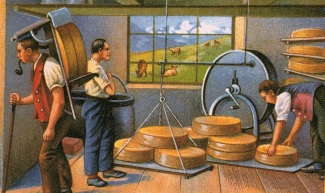Bill Neal’s Cheese straws, which are really crackers.
 Cheese straws incorporate a mere handful of ingredients and it is a simple matter to bake them, so it may be surprising that cooks use so many different recipes to make them. Some writers insist on only Cheddar, some on Parmesan; all of them ought to include cayenne. As in so many things, we like the approach taken by Bill Neal.
Cheese straws incorporate a mere handful of ingredients and it is a simple matter to bake them, so it may be surprising that cooks use so many different recipes to make them. Some writers insist on only Cheddar, some on Parmesan; all of them ought to include cayenne. As in so many things, we like the approach taken by Bill Neal.
-8 Tablespoons unsalted butter
-about 1 2/3 cup grated Cheddar (6 oz by weight)
-about 2/3 cup grated Parmesan (2 oz by weight)
-1 ½ cups flour
-¼ teaspoon salt
-3/8teaspoon cayenne
Preheat the oven to 325°.
- Beat the butter until fluffy.
- Beat the cheeses into the butter, then stir the other ingredients into the mixture until the dough is homogeneous and smooth.
- Roll the dough into balls “the size of a strawberry.”
- Put the doughballs on a cookie sheet and flatten each one with the tines of a fork.
- Bake the ‘straws’ for about 15 minutes, or just until the bottoms of the crackers turn golden brown.
Notes:
- The recipe is adapted from Neal’s lovely Biscuits, Spoonbread & Sweet Potato Pie (Chapel Hill 1990); the quotation at Step 3 of the bfia recipe is from page 59 of the same source.
- The timing of the cheese straws can be tricky. If you do not bake them long enough, they will not acquire their essential crispy texture, but if you bake them for too long, they will toughen like overfried cheese.
- Using a fork to set the shape of the straws is a typically deft move by Neal that other writers overlook; it is a simple and effective way to enhance the crunch of the straws, analogous to the ‘nooks and crannies' that allow Thomas’s English muffins to toast so well.
- John Martin Taylor includes a recipe in Hoppin’ John’s Lowcountry Cooking (New York 1992). He only uses Cheddar, along with a 1:1 ratio of cayenne and red pepper flakes (we do not recommend inclusion of the harsher flakes), and bakes his straws (or ‘pigs’) at a higher temperature (350°) for a longer period (25 minutes), which we consider risky. He does not know the fork trick.
- Elizabeth David insists on the blanket inferiority of English cheeses to Parmesan for cooking. We do not agree with her.
- Like Martin, Elisabeth Ayrton uses Cheddar alone to make her straws. Unlike Martin, Mrs. Ayrton does not consider it inauthentic to wrap, fold and roll the cheese within puff pastry, and in our book she should know. Unlike many writers, the ‘straws’ that emerge from Mrs. Ayrton’s recipe actually look like straws. Hers is a handy recipe because you need not take the laborious route that entails beating together the ingredients to form a dough: She recommends the use of (thawed) frozen puff pastry. Mrs. Ayrton takes a thin sheet of puff pastry weighing 4 oz and sprinkles half of it with 2 oz by weight of grated Cheddar (or Cheshire) cheese before folding the other half of the pastry over the cheese and rolling it out from the spine toward the open edge “to seal the cheese.” Then she folds the dough again, the long way, and rolls it again to a thickness of only about 1/8 inch. She then cuts the dough against its length into straw-wide batons. To make each straw, bundle 6 batons and wind a seventh around them “so that they look like little sheaves of corn [wheat in American usage].” Bake the straws, or sheaves, or perhaps fasces, on a lightly floured cookie sheet at 450° for 5-7 minutes or until golden. “They will,” as Mrs. Ayrton writes, “reheat perfectly.” Quotations are from The Cookery of England (London 1974) 424.
- We cannot resist noting that The Cookery of England is a meditation on the history of English foodways as well as a comprehensive compilation of recipes. In homage to the style favored by the great eighteenth century British cookbook authors, mostly women, she playfully subtitles the book ‘being a Collection of Recipes for Traditional Recipes of All Kinds from the Fifteenth Century to the Present Day, with Notes on their Social and Culinary Background.’ Try getting a publisher to accede to that earful today.
- The bookshelf of any serious student of British cookery, for that is what they call it, must include a copy of The Cookery of England.

